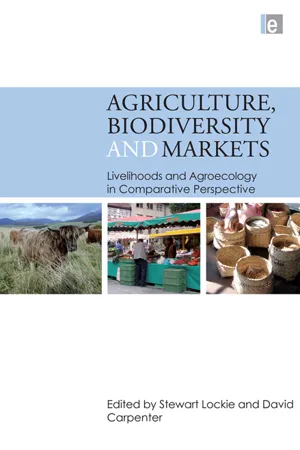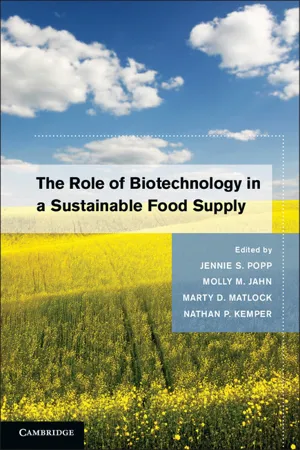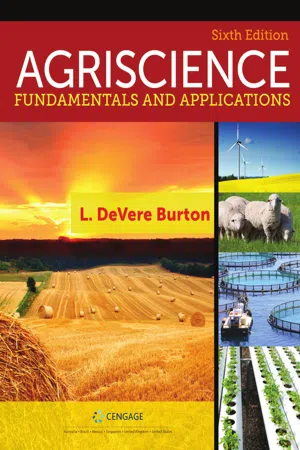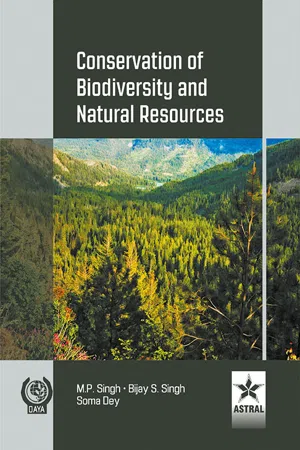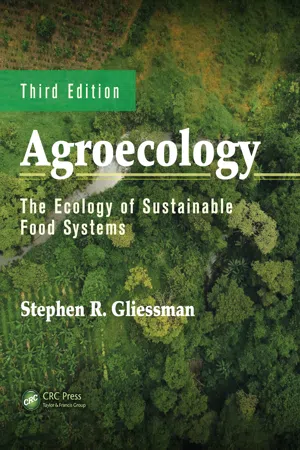Biological Sciences
Agriculture
Agriculture is the practice of cultivating soil, producing crops, and raising livestock for human use. It involves various biological processes such as plant growth, soil fertility, and animal husbandry. Agriculture plays a crucial role in providing food, fiber, and other resources essential for human survival and economic development.
Written by Perlego with AI-assistance
Related key terms
1 of 5
7 Key excerpts on "Agriculture"
- eBook - ePub
Agriculture, Biodiversity and Markets
Livelihoods and Agroecology in Comparative Perspective
- Stewart Lockie, David Carpenter(Authors)
- 2009(Publication Date)
- Routledge(Publisher)
In coming to deal with the place of food production in industrial societies we face a set of strong tensions. There is the productivist view of Agriculture as a technical problem of how best to exploit particular biophysical structures and functions to produce the maximum amount of useable food and fibre. Set against this is a spectrum of views of Agriculture as a socio-cultural activity that all but defines a particular society or nation, farming as a way of life, through to it being seen as a key agent of economic development. Riding uneasily with all these is the growing understanding of the place of Agriculture as the dominant form of human land management on the planet that must account for many landscape functions and processes other than just providing for human needs. We need a framework for understanding Agriculture in all its complex roles of providing human sustenance and cultural meanings, as well as delivering ecosystems services.To quote the noted American agricultural essayist Wendell Berry (1977), ‘the problem with Agriculture is a problem with culture’. Fundamentally, Agriculture is a human cultural activity that only exists as a major form of landscape process because there are humans doing it. The purpose of this chapter, therefore, is to contextualize the problem of biodiversity decline within a human ecological understanding of Agriculture and related ecosystem processes. In basic terms, human ecology encompasses the relationships we, as a species, have with the fundamental biophysical processes of the planet, mediated through the understandings that we generate of those processes through human action and interaction.From this perspective, agrobiodiversity is seen not just as the sum of agricultural or wild resources necessary for food and fibre production (i.e. crop varieties, pollinators etc). It also includes the practices and food production systems employed by farmers throughout the world to dynamically manage those resources (see Brookfield and Padoch, 1994). It is these myriad local practices that continue to maintain and expand in situ the genetic diversity that underpins agricultural production. As such, agrobiodiversity cannot be divorced from the rich cultural diversity and local knowledge that underpins livelihood systems (Thrupp, 2000). - Jennie S. Popp, Molly M. Jahn, Marty D. Matlock, Nathan P. Kemper(Authors)
- 2012(Publication Date)
- Cambridge University Press(Publisher)
Although these principles are very aspirational, they can also guide formulation of specific goals for sustainability within a sector of the global economy. Agriculture represents the core of all economic systems and has the largest global and ecological footprint. If sustainable agricultural practices can be 239 240 The Context for Biotechnology in Sustainable Agriculture adopted, much progress can be made in moving the entire supply chain of goods and services across the economy to a sustainable footing. Sustainable goals for Agriculture can be formulated to respond to these definitions and principles of sustainability. In response to these aspirations and the very real challenges facing humanity in the next 40 years, the goals of sustainable Agriculture must include the following: 1. Provide secure and safe food, feed, fiber, and fuel supply chains globally to feed 9.25 billion people by 2050. 2. Increase global production with no loss of habitat. 3. Increase global production with reduced impacts on water resources. 4. Increase global production with fewer inputs (fertilizer, energy, pesticides, labor). 5. Increase global production while increasing ecological services. 6. Increase global prosperity through equitable resource allocation in global markets. The role of biotechnology in meeting these objectives must be evaluated in the context of the pressures on Earth’s critical ecosystem services. These pressures are a function of current global population dynamics, increasing demands for agricultural products, land use pressures associated with those demands, and water resource demands. The context of biotechnology in reducing these stresses should include an assessment of the implications of global climate change on agricultural production and the opportunities demonstrated by biotechnology to address these challenges. Global Population Dynamics and Agricultural Production In 2010 the human population on Earth reached 6.8 billion.- eBook - PDF
- Preethi Kartan(Author)
- 2019(Publication Date)
- Delve Publishing(Publisher)
Agriculture is important for providing food, nutrition and raw material for human beings. The increasing population will need a greater number of raw materials and huge amounts of food as a result of which a number of biotechnological principles are being used to produce plants with increased productivity and resistance to abiotic factors. The need for agricultural biodiversity, importance of agricultural diversity, challenges, role of diversity in crop production, importance of biotechnology in agricultural biodiversity have been explained, important techniques of biotechnology that are used in Agriculture are explained. The socio-economic perspective of biotechnology in agricultural biodiversity has been explained. The different advantages of biotechnology have been explained in detail. 2.1 INTRODUCTION TO AGRICULTURAL BIODI-VERSITY Agricultural biodiversity refers to the interrelationship and connections between the genetic resources, the environment and the management systems that are followed by and utilized by the farmers. The important result of this is that it could be because of the theory of natural selection where the stronger and healthier traits get chosen and the lesser healthier traits are lost in the process of evolution and development. In addition, the result of the human imagination that has been evolving over a period is growing along with agricultural diversity. The different magnitudes of agricultural biodiversity can be categorized in the following way: • Genetic Resources for Food and Agriculture • Components of biodiversity that support ecosystem services • Abiotic factors • Socio-economic and cultural dimensions Agriculture Biodiversity and Biotechnology 33 Figure 2.1: Biodiversity. - L. DeVere Burton(Author)
- 2018(Publication Date)
- Cengage Learning EMEA(Publisher)
achievement. b. intelligence. c. intuition. d. spontaneity. 2. The percentage of an average U.S. worker’s pay that is used for food is a. 9.4 percent. b. 14.5 percent. c. 50 percent. d. 74 percent. 3. The best term to describe the application of scientific principles and new technologies to Agriculture is a. agribusiness. b. renewable natural resources. c. farming. d. agriscience. 4. Harmful insects, rodents, and diseases are all referred to as a. animals. b. plants. c. pests. d. parasites. 5. Agriscience encompasses a. wildlife and fish. b. ornamental plants and trees. c. farms and agribusinesses. d. all of the above and more. SELF-EVALUATION 1. Write the Terms to Know and their meanings in your notebook. 2. List examples of animals that have superior senses than do humans. Indicate the sense(s) along with the animals. 3. Write a paragraph or two on (1) cave, (2) lake, and (3) cliff dwellers. Explain how the types and locations of their homes provided protection from (1) animals and (2) unfavorable weather. Access to an online encyclopedia would be a good resource for this activity. 4. Ask your teacher to assign you to a small discussion group to talk about the responses to Activity 3. 5. Place a map of your school community on a bulletin board. Insert a colored map pin in every location of a farm, ranch, or agribusiness in your school community. 6. Talk to your County Extension Agent or another agricultural leader regarding the importance and role of agriscience, agribusiness, and renewable natural resources in your county. 7. Select one of the sciences mentioned in this unit. Prepare a written report on the meaning and nature of that science.- eBook - PDF
Organic Farming
A Promising Way of Food Production
- Petr Konvalina(Author)
- 2016(Publication Date)
- IntechOpen(Publisher)
Section 1 Organic Farming and Plant Production Chapter 1 The Role of Biological Diversity in Agroecosystems and Organic Farming Beata Feledyn-Szewczyk, Jan Kuś, Jarosław Stalenga, Adam K. Berbeć and Paweł Radzikowski Additional information is available at the end of the chapter http://dx.doi.org/10.5772/61353 Abstract Ecosystems are the basis of life and all human activities. Conservation of biological diversity is very important for the proper functioning of the ecosystem and for delivering ecosystem services. Maintaining high biodiversity in agroecosystems makes agricultural production more sustainable and economically viable. Agricul‐ tural biodiversity ensures, for example, pollination of crops, biological crop protec‐ tion, maintenance of proper structure and fertility of soils, protection of soils against erosion, nutrient cycling, and control of water flow and distribution. The effects of the loss of biodiversity may not be immediately apparent, but they may increase the sensitivity of the ecosystems to various abiotic and biotic stresses. The combination of biodiversity conservation with profitable food production is one of the tasks of modern sustainable Agriculture that faces the necessity of reconciling the productive, environmental, and social goals. As further intensification of production and increase in the use of chemical pesticides, fertilizers, and water to increase yields are increas‐ ingly criticized, global Agriculture is looking for other biological and agrotechnical methods in order to meet the requirements of global food production. Keywords: Biological diversity, ecosystem, agroecosystem, ecosystem services, organ‐ ic Agriculture 1. Introduction In compliance with the Convention on Biological Diversity (CBD), adopted in Rio de Janeiro in 1992, biological diversity is the variability among living organisms inhabiting all environ‐ © 2016 The Author(s). - Singh, M P, Soma Dey(Authors)
- 2021(Publication Date)
- Daya Publishing House(Publisher)
Natural processes provide the services on which all agricultural production relies, such as water and nutrient supply, oil fertility, pollination, stabilization of atmospheric composition, and regulation of biogeochemical cycles. Respecting ecological constraints means keeping the flows of biomass produced int he agroecosystem by human management within a range of values that is compatible with regulation mechanisms typical of natural ecosystems. A large discrepancy between the actual density of agricultural throughput and the densities imposed by either socio-economic or ecological constraints indicates unsustainability of agricultural production. Agriculture is ecologically unsustainable when the acutal density of agricultural throughput This ebook is exclusively for this university only. Cannot be resold/distributed. exceeds the critical environmental loading, and socioeconomically unsustainable when the actual density of agricultural throughput is too low to provide food security and/or economic viability for farmers. Agriculture can be defined as a human activity that exploits natural processes and natural resources in order to obtain food and other products considered useful by society. The verb ‘exploits’ suggests that we deal with an alternation. Indeed, within a defined area humans alter the natural distribution of animal and plant populations in order to selectively increase the density of certain flows of biomass that they consider more useful for the socio-economic system. Adopting this definition, we implicity assume that Agriculture has to do with manipulation of biodiversity. Following the schema of ecosystem structure proposed by Odum, a natural ecosystem can be seen as a network of matter and energy flows in which nutrients are mainly recycled within the system and solar energy is used to sustain this matter cycling.- eBook - PDF
Agroecology
The Ecology of Sustainable Food Systems, Third Edition
- Stephen R. Gliessman(Author)
- 2014(Publication Date)
- CRC Press(Publisher)
Clearly, something is going on that merits closer examination—and that something, we sug-gest, is related to beliefs, political commitments, economic interests, and the ways people interpret ideas and facts. To understand these factors, we must take a step back, look beyond Agriculture itself, and examine the broader context within which Agriculture operates; that is, we must look at markets, economic structures, government policies, politics, the struggles that occur between groups with different lev-els of power, and the conceptual frameworks people use to understand these things—all of which is included under the rubric of society . In taking this approach, we can begin to see that there are very strong social and economic reasons Agriculture, Society, and Agroecology 302 Agroecology: The Ecology of Sustainable Food Systems why human societies are moving in a seemingly irrational direction with regard to Agriculture and why there is such widespread commitment to continuing in this direction. We began to explore the relationship between Agriculture and society in Chapter 2. In that chapter, we examined agro-ecosystems as human-managed ecosystems that respond to human needs and goals. Then we explored how, by scaling up the most concrete form of agroecosystem—the crop field or individual farm—we can conceptualize successive agroeco-system levels ranging through the region and the rural–urban landscape to the single, interconnected global food system. By taking into account all the manifestly social activities of producing, distributing, and consuming food, the agroeco-system concept puts Agriculture in a social context. But this is only the beginning of where we need to go, because the relationship between Agriculture and society embodied in the agroecosystem concept is mostly formal.
Index pages curate the most relevant extracts from our library of academic textbooks. They’ve been created using an in-house natural language model (NLM), each adding context and meaning to key research topics.
